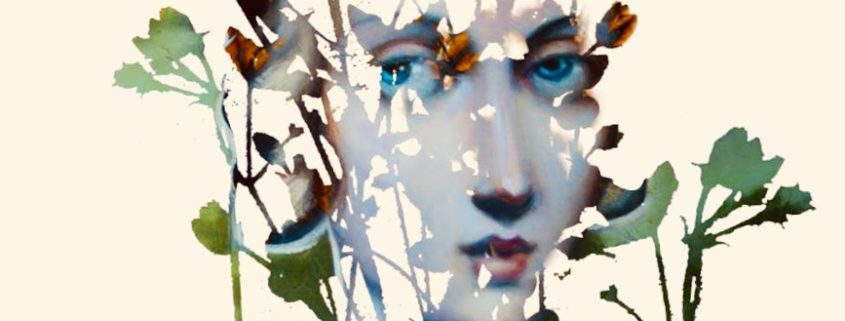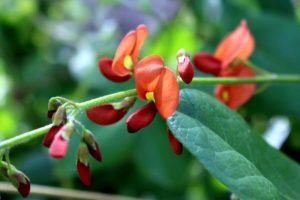Georgiana Molloy & the Language of Flowers
‘The language of flowers has recently attracted so much attention, that an acquaintance with it seems to be deemed, if not an essential part of a polite education, at least a graceful and elegant accomplishment.’
Flora’s Lexicon: an Interpretation of the Language and Sentiment of Flowers 1839
That was written in 1839, but interest in the language of flowers seems to be having another moment in 2018. I chose to use a quote from this beautiful book to close Georgiana’s own story so I thought you might like to know more about her connection with it and some background to the history of ‘floriography’.
Captain James Mangles sent a copy to Georgiana in 1839. It was a brand new publication and something she could not buy for herself. Books were expensive items and there were no bookshops in the tiny sub-colony of Augusta! When she wrote back to thank him in early 1840, she was delighted with the book and told him how she often shared it with her children as a special treat. She was writing in January—the middle of summer in Western Australia— from her new home in Busselton.
The beautifully executed illustrations of the “Green House” the Language, and Sentiment of Flowers I could look at repeatedly with unwearied pleasure, not a little encreased [sic] by calling them my own — I often after a day spent in servile drudgery from the want of Domestic’s sit down quite exhausted with one of your beauteous presents in my hand, — when I receive great refreshment and relaxation; — when leave is granted for Captn Mangles’ Books to be looked at, a clean cloth is laid, Sabina & Mary are permitted to regale themselves with the sight —
Transcribed from the letter-books of Captain James Mangles SLWA ACC 479A
Of course, the idea of flowers having a message to convey is ancient and evident in cultures all over the world, which explains why so many flowers have multiple associations. Plants have been food and medicinal sources for thousands of years so they have a significant place in the cycles of life and people have used flowers as part of rituals and ceremonies. For example, many cultures associate the white Lily with women and motherhood; it’s the colour of the moon. The Lotus grows pale and perfect from the mud below it so, unsurprisingly, it’s used as a symbol of purity. Other associations are less obvious because they connect with the way people use plants. For example, in medieval times when Yew trees were needed for their strong, flexible timber (the best for making English longbows) they were often planted in a graveyard. Yew is highly poisonous and, before enclosure when fields were open, the local churchyard was safely closed-in behind a wall, keeping the toxic Yew leaves away from grazing animals and wandering children. Unsurprising, then, that Yew is commonly a symbol of life / death, mortality / immortality. By the time Shakespeare was writing about ‘rosemary for remembrance’ and mentioning the bitter tasting herb, rue, as a symbol of Ophelia’s regret and sorrow, the idea of using flowers to convey widely shared messages was commonplace.
During the nineteenth century the trend for sending secret messages through flowers became high fashion and new meanings were added to the ancient ones. If you search the Internet you’ll find many books on the subject published at that time, available to view online. The botanical basis for entries is sometimes haphazard, using a varied combination of botanical names and common names within the same book. I don’t think any of that mattered to the readers, who delighted in the idea that they could say what they wanted to say in a delightfully secret way, during an era when the expression of emotional feelings was generally suppressed in public and even in the home.
In floriography, the new idea of creating a bouquet from several species allowed people to send a more complex message, by combining the meanings of more than one kind of flower, almost like a complete sentence. The book Georgiana enjoyed so much suggested the following:
Crown Imperial / Turks cap Lily / Lily of the Valley = You have the power to restore me to happiness
Rose / Ivy / Myrtle = To beauty, friendship and love
There are so many pleasures in reading about the way people engage with flowers, especially in these original publications. The words themselves, the old names of plants and species that are no longer common in our gardens, have a beauty of their own. I like to say them aloud.
Tansy Teasel Trefoil.
Whortleberry Willowherb Wood sorrel Wormwood
Perhaps that’s why interest in a ‘floral language’ has never died away and seems to be more popular than ever. I read Vanessa Diffenbaugh’s lovely book, The Language of Flowers’ when this debut novel was first published and became a book club favourite, along with her ‘flower dictionary’. It’s the story of Victoria, a troubled child who moves from one foster parent to the next and grows up to be a fire-starter and a loner.
‘For eight years I dreamed of fire. Trees ignited as I passed, oceans burned. The sugary smoke settled in my hair as I slept, the scent like a cloud left on my pillow as I rose. Even so, the moment my mattress started to burn, I bolted awake. the sharp, chemical smell was nothing like the hazy syrup of my dreams; the two were as different as Indian and Carolina jasmine, ‘separation’ and ‘attachment’. They could not be confused.’
As a young woman, Victoria learns to use the language of flowers to help others say what they are feeling and she herself begins to heal. An ancient lore, still meaningful and powerful.
‘The Language and Sentiment of Flowers’ became a special book for me too. When I began writing Georgiana’s biography, I spent an afternoon reading through the book of Robert Burns’ poetry she brought with her to Western Australia in 1829. I knew I’d find within its pages the guiding light I needed to keep me on the right path. I chose a line from an adaptation of an old Scottish song in that anthology, and I kept the words pinned next to my desk while I was writing. The poem is about a young woman. Burns ends every verse saying that, although she’s beautiful in every way, it’s her mind that shines most of all. ‘Tis the mind that shines in every grace. In the same moment I chose the line, it became the subtitle for my book.
More than a year later, as I came close to finishing, I found a copy of ‘The Language and Sentiment of Flowers’ online and read it myself for the first time. It gifted me the last lines I wrote, the final page.
‘I wondered which flower Georgiana would have looked up first when the precious book arrived, and I guessed it would have been the red Kennedia that she loved so much. It was her namesake. It weighed down the rafters of her verandah by the river in Augusta. The botanist James Drummond remembered her for it publicly in the last days of her life at Fairlawn.’
I found it between Juniper and Larkspur; Class Diadelphia, Order Decandria, a plant ‘of rare delicacy and beauty’. In the language of flowers, Kennedia is the floral messenger for mental beauty.
If you’d like to enjoy ‘Flora’s Lexicon: The Language and Sentiment of Flowers’ at your leisure, you can find it (1855 edition) on the website of the wonderful Biodiversity Heritage Library here:
https://www.biodiversitylibrary.org/bibliography/18390#/summary
And I’d love to hear about the floral messages you decide to send.
Here’s a Post Script, more information about Georgiana’s 1840 letter:
I’ve written before about the differences between the original texts and the transcriptions in ‘Georgiana Molloy: Portrait with Background’ the biography by Antonia Hasluck (Fremantle Arts Centre press 2002) but it’s worth noting in passing that I found more than twelve changes from the original in just these few lines. Whoever Mangles’ scribe was for the letter-book, the idiosyncrasies of punctuation and spelling may have been his or hers during the first layer of transcription from Georgiana’s originals. Hasluck’s intention may have been to assume that Georgiana’s spelling and punctuation were more accurate than the unnamed scribe and make the changes accordingly but I prefer to stay with what we have as the only evidence of the original letters. I believe Georgiana herself did write the word ‘beauteous’ and not ‘beautiful’ as in the Hasluck transcription.








